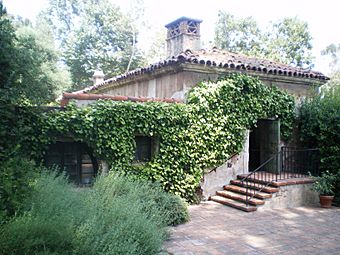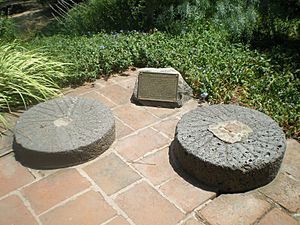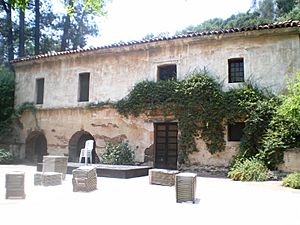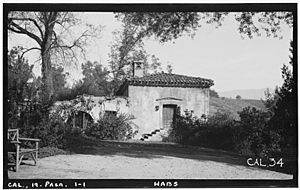El Molino Viejo facts for kids
Quick facts for kids |
|
|
El Molino Viejo
|
|

El Molino Viejo, July 2008
|
|
| Location | 1120 Old Mill Rd., San Marino, California, United States |
|---|---|
| Built | 1816 |
| Architect | José Maria de Zalvidea |
| Architectural style | Colonial |
| NRHP reference No. | 71000154 |
| Added to NRHP | May 6, 1971 |
El Molino Viejo, also known as The Old Mill, is a very old building in San Marino, California. It was built way back in 1816 by Father José María de Zalvidea from the Mission San Gabriel Arcángel (San Gabriel Mission). This amazing building is the oldest commercial building in Southern California. It was one of the first ten places in Los Angeles County to be added to the National Register of Historic Places in 1971. The Old Mill is also recognized as a California Historical Landmark.
Contents
Building the Old Mill

Records from the San Gabriel Mission show that the mill was built in 1816. It was constructed on land owned by the Mission. Father José Maria de Zalvidea, who was in charge of the Mission at the time, designed the building. Tongva Native Americans, who worked at the Mission, helped build it under Father Zalvidea's guidance.
The mill was built to be very strong, almost like a fortress. Its lower walls are nearly five feet thick at the bottom. They are made of brick and a type of volcanic rock. Some people believe these thick walls were meant to protect the priests if there were problems with the people who had recently joined the Mission. The upper walls are made of sun-dried adobe bricks. The outside of the building is covered with a special plaster made from burnt seashells.
The large wooden beams inside are made from pine and sycamore trees. They are held together with leather strips. The building also has big supports called buttresses on its outside corners, which you can still see today.
How the Mill Worked
Water was brought to the mill through an open ditch from nearby canyons. This water was stored in a large tank called a cistern. Father Zalvidea designed a special water wheel for the mill. It was a horizontal wheel, which was unusual for the time.
On the ground floor, there were three arched rooms for water. The water wheel was connected to a pole that went up to the second floor. This is where the grinding stones were located. One grinding stone was attached to the pole and spun with the water wheel. Another stone was placed on top of it. Corn and grain were put between these two stones to be ground into flour.
It is thought that the water from the cistern might not have been strong enough to start the wheel spinning on its own. So, Native Americans might have used a leather strap wrapped around the pole to help start the wheel. The top room of the mill, which is now an art gallery, was used to store the finished flour. After the water left the mill, it flowed into a lake called Wilson Lake. This lake was later drained in the 1920s and is now Lacy Park in San Marino.
This was the first water-powered grist mill in Southern California. Some even say it was the first in all of California. While some people thought Father Zalvidea's design was very clever, others believed it had a problem. Water would splash up the pole, making the flour damp. The mill only worked for about seven years. During this time, it helped provide food for the missionaries and the Native Americans living at the Mission. In 1823, a new, more modern mill was built near the Mission. This new mill made better flour, so the Old Mill stopped being used.
The Old Mill's Many Lives
After the new mill opened in 1823, the Old Mill was empty for about 30 years. During this time, it was damaged by people and by the weather.
New Owners and Residents
In 1858, a doctor named Thomas White sold the "Old Mill Site" to his daughter, Fannie Kewen. Fannie and her husband, Colonel Edward J. C. Kewen, lived there for 20 years. The Kewens made changes to the building, adding French windows and a front porch. They were known for hosting many parties at the Old Mill. People would come from miles around to enjoy their friendly gatherings. It was said that "the brave and happy gathered... and danced happy dances on the floors that once had echoed the quiet footfall of the priest."
In 1879, the Kewens lost the property because they couldn't pay their mortgage. It was then sold to John Edward Hollenbeck, who later sold it to Edward Mayberry in 1881. Mayberry used the building as a home for the person who managed his ranch.
Rediscovery and New Purpose
In 1898, a reporter visited El Molino Viejo. At that time, the mill was being used to store wine, and it smelled like wine inside. It was also a sleeping place for workers. The reporter noted that even though the grinding stones and machinery were gone, the building itself showed no signs of falling apart. The large oak beams were still strong, and the cement seemed to last forever. The old millstones were found nearby and were being used as stepping-stones.
In 1903, the Huntington Land and Improvement Company bought the mill site. When the Huntington Hotel opened nearby in 1914, the land around the mill became a golf course. El Molino Viejo was used as the golf clubhouse. Later, the land was divided up, and the Old Mill became empty again.
Becoming a Home and Museum
In 1927, Leslie Huntington Brehm, whose husband was the son of Henry E. Huntington, took over the property. She wanted to save it. She hired Frederick H. Ruppel, a builder who had restored other historic missions. Ruppel turned the mill into a modern home but kept the original walls. He also made sure that any new parts looked like the old Mission style. The Brehms never lived in the Old Mill themselves, but they rented it out to several families. The last family to live there was the Connell family, from 1954 to 1963.
When Mrs. Brehm passed away in 1962, she left the Old Mill to the City of San Marino. The city has taken care of the building and opened it to the public. Today, it is a museum and an art gallery, run by the Old Mill Foundation. You can visit the museum Tuesday through Sunday from 1 p.m. to 4 p.m. Inside, there is a model that shows how the mill used to work.
Although the waterwheel is gone, two of the original millstones are displayed in the garden. These millstones were found more than 100 years after the mill closed. General George S. Patton, who grew up in the area, found them on the grounds of the Huntington Library. He remembered seeing them used as blocks to help people get on horses. There is also a very old fountain from the 1500s in the patio. This fountain was brought from Mexico by Mrs. Brehm's daughter.
The Legend of Catalina
In 1898, a story was told about a natural spring at the Old Mill site. It was about a 16-year-old Native American girl named Catalina. She had "thick, jet-black hair" and "big, melting black eyes." Catalina lived during the time of the San Gabriel Mission. She would give roses to the Virgin Mary, hoping to win the heart of a handsome young man named José. She even wished something bad would happen to another girl José liked.
When José left for two years to work on a ship, Catalina stopped praying to the Virgin Mary. Instead, she started praying to an old "Mexican god," described as a "hideous clay image." Catalina died of sadness when José did not return. Her body was buried where the mill was later built, a spot where spring water "slowly oozes" from the ground. According to the legend, this oozing water is "only the tears from a loving woman's broken heart."
Historic Recognition
El Molino Viejo is the oldest commercial building in Southern California. Because of its importance, it has been recognized as a historic site at both state and national levels. In 1937, it was recorded by the Historic American Buildings Survey. It was one of the first ten places in Los Angeles County to be added to the National Register of Historic Places in 1971. It is also a California Historical Landmark (No. 302). The marker says:
- NO. 302 OLD MILL – The Old Mill, El Molino Viejo, was designed by Father José María Zalvidea and built of fired bricks and adobe about 1816 to serve Mission San Gabriel. Another grist mill was built in 1823 near the mission and the old mill was gradually abandoned – it passed from mission control in 1846. The property remained in private hands until 1903, when Henry E. Huntington bought the building and used it for a golf clubhouse. Later owners, Mr. and Mrs. James Brehm, had the mill restored in 1928 by Frederick Rupple.
See also






